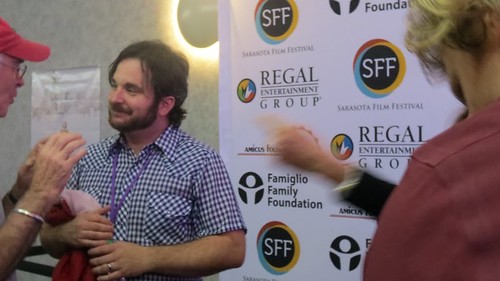
With only one showing at the Sarasota Film Festival last Wednesday, April 15, the highly anticipated “The End of the Tour” was sold out way in advance. Consequently, by 6 p.m. – an hour until doors – the stand-by line began to accumulate outside the theater.
A relatively simple narrative with a beautiful, hearty and rich script, “The End of the Tour” is based off a Donald Margulies adaption of a David Lipksy work titled “Although Of Course You End Up Becoming Yourself,” which chronicles the writer’s five-day road trip with David Foster Wallace at the end of Wallace’s “Infinite Jest” book tour.
After the movie, the audience was given a question and answer session with Director James Ponsoldt and actress Mickey Sumner, who played the character Becky. Ponsoldt detailed his time reading Wallace’s massively popular, thousand-page novel as a freshman in college. “It changed my life,” he said. “Subsequently, I tried to devour everything I could find from David Foster Wallace.”
“He’s the internal monologue when I’m engaging with culture or issues of ethics, morality, of how to be a better person, how to deal with pop culture, how to deal with literature, how to deal with abstract ideas, how to deal with concrete ideas – all these things – how I feel about an album, how I feel about an athlete, whatever it is,” Ponsoldt continued. “He’s the voice that I hear in my head and that I sort of aspire to.”
Lipsky is played by Jesse Eisenberg and Wallace by Jason Segel. Both actors were the actual age of the characters they were portraying, 30 and 34 respectively. Eisenberg and Segel act in the roles so seamlessly, instigating such a tangible connection between the characters that one would think the duo has been working together for a long time. Much of the script, carried out in simple settings, is conversation between Wallace and Lipsky, highlighting not necessarily what the actors are doing, but instead what they are saying.
“They are both really, really smart guys and great writers, it’s worth noting,” Ponsoldt said of the two protagonists. “Jesse Eisenberg writes humor pieces for the ‘New Yorker,’ he has a play that he wrote that is about to be produced on Broadway.”
“Jason Segel has written a ton of movies. He’s the guy that revived the Muppet franchise as a writer, as an actor, and as a producer. He’s written other comedies – he’s about to write the new Lego Movie,” Ponsoldt added. “It was a real gift to have that cast.”
An announcer opened the movie discussion by saying that viewing the film is actually “a transformative experience.” While the film illustrates many themes and motifs, one of the most appealing is that of art journalism and the portrayal of artists in the media. Eisenberg did a nice job displaying the apprehension his Ivy League-educated character had before interviewing Wallace. This apprehension is something many journalists grapple with on a daily basis. The idea of recording a fellow human, engraving their words, returning to them later in a different context, and using them for a story that will be published to a massive audience, is an incredibly dubious task, one that Wallace was clearly uncomfortable with from the start.
Ponsoldt, also credited for 2013’s “The Spectacular Now,” gave advice to the Catalyst for aspiring art journalists. “Consume everything. Don’t be a snob. Be generous, but try to be honest. And read and consume and read and consume,” Ponsoldt said. “I think some of the most you can learn about writing sometimes is by reading, a lot. Find critics and journalists who write about art that really inspires you.”
“I have so much deep respect for great journalists and great critics,” Ponsoldt said in the question and answer session.
Set in the 1990s, when everyone could smoke everywhere, the characters ponder the effect of technology in the coming years. Wallace, who possesses a clear television addiction, basically thinks that increasing virtualization of life will not only make it okay, but make it actually pleasurable for us, to be more and more alone.
It is hard to describe the vast array of ideas touched upon in all of the pair’s conversations. An interesting point was made concerning the connection between artists and audience. Similar in ways to musicians who write their own lyrics in a quasi-diary sort of way, Wallace and Lipsky question if, because “Infinite Jest” is so personal, reading the book equates to reading Wallace himself.
“I think I have a little bit of understanding into how that relationship can get really blurry,” Ponsoldt said of this artist and audience connection. “How you can meet someone who has created a lot of art that has really moved you and you think you know them, but how when you meet them in the flesh they can be a lot different in their own humanity. It muddles things and complicates the relationship.”
“That’s a really complicated, weird thing that involves a lot of emotional transference and can sort of bring out your own insecurities and anxieties,” Ponsoldt added.
As the silent bond grows between Wallace and Lipsky, the two begin to, almost accidentally, dive deeper into each other’s psyche, so much so that at one point Lipsky asks, “Hey, who’s interviewing who?” Even though “The End of the Tour” possesses a fair share of deep and serious topics, the occasional blip of humor got the whole audience – obviously enthralled with the film – laughing.
“The End of the Tour” is scheduled for a late July limited release, eyeing an Oscar run in the future.
Information for this article was taken from www.imdb.com.
